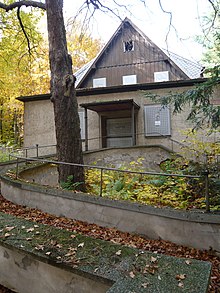Borna lung sanatorium
The Borna Lung Sanatorium , which was founded in 1906 as König-Friedrich-August-Walderholungsstätte by the Association to Combat Consumption in Chemnitz and the surrounding area , was dedicated to the treatment of tuberculosis and other lung diseases until 1998 .
From the foundation to the 1920s
The lung sanatorium, located in the Crimmitschau forest, provided relief to the sick with recumbent cures and adequate food. However, in 1910 the facility had to make way for the new hospital buildings of the Küchwald Hospital, which opened in 1915. A new location in Borna , on the border with the communities of Heinersdorf , Wittgensdorf and Röhrsdorf , was inaugurated and occupied in May 1911. In order to meet the requirements of a lung sanatorium, the planting of a forest, today's "Heilstättenwald", began immediately. The new location, located in a valley, was characterized by favorable climatic conditions.
The pulmonary hospital only accepted people who were tuberculous, suspected of having tuberculosis or who had other lung diseases. For this purpose, 140 beds were available in five buildings, of which 72 were intended for the accommodation of adults and 68 for the accommodation of children. The facility was heated by hot water, had four lounge halls, as well as an air bath and a sun bath. In addition, the institution was equipped with a bathhouse, a laundry, several disinfection rooms and a nursery with a greenhouse. From 1925 it was named Heil- und Erholungsstätte Chemnitz-Borna.
The children's home
As early as 1911, a special children's house was set up to treat tuberculous children. In the basement of the house there were boilers, a bathing system with two tubs and two showers, as well as a utility cellar. 15 boys were accommodated in a bedroom specially prepared for them on the first floor. A lounge for boys and girls, a hot kitchen, a storage room for shoes and a nurses' room were also located on the ground floor, to which a 16-meter-long lounge hall was connected. The upper floor of the house accommodated a bedroom for 15 girls, a nurses' room and a clothes closet. Boys, girls and staff each had their own toilet. A separate air shaft next to the windows was used to ventilate the bedrooms. All rooms had electricity.
Until the building complex is closed
The lung sanatorium was expanded by new buildings until the late 1930s. Artillery fire caused major damage to the buildings during World War II. Because of this, the city of Chemnitz , which had taken over the sanatorium in 1946, initiated the reconstruction and construction of further new buildings in the 1950s. Thanks to improved treatment options, the number of people suffering from tuberculosis has fallen since the 1960s. While the number of beds was around 125 in the 1980s, it fell to around 90 beds in the 1990s.
With the establishment of the Chemnitz Clinic for Internal Medicine IV, which concentrated the areas of lung diseases , allergology and sleep medicine , the building complex of the Borna lung sanatorium was closed in 1998. The buildings have been preserved, but are in a dilapidated state, marked by vandalism and environmental influences. The Chemnitz city council decided in March 2011 to demolish the building, which began in mid-February 2013.
literature
- B. Schubert, S. Weingart: The association to combat consumption in Chemnitz. In: Chemnitzer Geschichtsverein eV (Hrsg.): Messages of the Chemnitzer Geschichtsverein (= yearbook 76th new series XV). Self-published by the Chemnitzer Geschichtsverein, Chemnitz 2006, ISBN 3-936241-08-2 , pp. 95–120.
- A. Thiele: Tubercular children. Leipzig 1905, pp. 232-241.
- S. Weingart: The association to combat consumption in Chemnitz. In: Chemnitz Roland. 5 (1989) 2, pp. 10f.
Web links
- Houses of the Chemnitz Clinic gGmbH
- Essential Nights - Heilstätte Chemnitz Borna page with pictures and videos
Coordinates: 50 ° 52 ′ 4 " N , 12 ° 52 ′ 29" E


